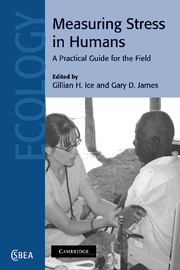1 - Conducting a field study of stress: general principles
Published online by Cambridge University Press: 11 September 2009
Summary
Introduction
In recent years, interest in the study of stress has expanded, particularly in the disciplines of anthropology and human biology where the focus of research has drifted toward evaluating the adaptive biological, cultural and psychological responses to stressors inherent in everyday living. Field studies of stress in these disciplines have been conducted across a wide continuum of contexts. These range from an assessment of the stress of “modernization” where biological and cultural responses of populations undergoing rapid industrialization/Westernization are examined, e.g. James et al. (1985), to the responses of people facing novel, new environments in modern, Western societies, such as occur in nursing homes (Ice et al., 2002).
Biologically, in studying the stress response, measurements can be made at any of several junctures in the psychophysiological pathways between stressful stimuli and adaptive or pathological outcomes. Measures include emotional/behavioral responses, hormonal variation in the sympathetic adrenal medullary system (SAMS), hormonal variation in the hypothalamic pituitary adrenal axis (HPA), physiological changes in the cardiovascular system and enhanced immune responses. The choice of the most appropriate measure will be determined by a combination of the goals of research, the population of interest and practical concerns. In addition to the particular stress marker(s) chosen for a study, the appropriate sampling strategy and design must be determined. These range from group comparisons of a one-time measure, to ecological momentary assessments, to multiple measures evaluated in a longitudinal design. Some study designs used in stress research require special analytic strategies and sophisticated statistical approaches.
- Type
- Chapter
- Information
- Measuring Stress in HumansA Practical Guide for the Field, pp. 3 - 24Publisher: Cambridge University PressPrint publication year: 2006
References
- 1
- Cited by



